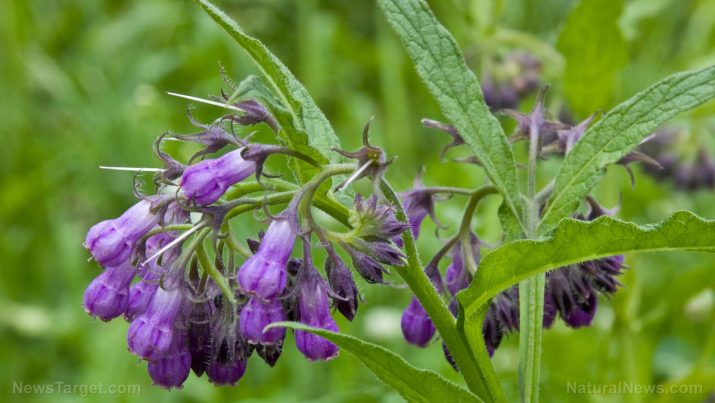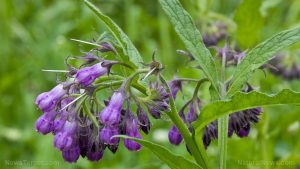
Comfrey – sources, health benefits, nutrients, uses and constituents at NaturalPedia.com
Saturday, September 02, 2017 by Rhonda Johansson
http://www.naturalpedia.com/comfrey-sources-health-benefits-nutrients-uses-and-constituents-at-naturalpedia-com.html

Comfrey is a perennial herb that has been harvested and used in folk medicine for more than 2,000 years. Traditional healers referred to the plant as “knitback” due to its astounding ability to speed wound and bone healing. While the shrub was much loved before, it is now just grown as an ornamental plant due to its long, slender leaves, and clusters of purple, blue, and white flowers. That said, it is currently going through a stage of revival as more wellness experts rediscover its use in medicine.
Take note that comfrey has been deemed to be a potential carcinogenic so the herb should never be taken internally. Nonetheless, it can be applied as a poultice or as part of a styptic, which is a substance that causes bleeding to stop. Modern ointments used for wound healing typically hold a comfrey content of five to 20 percent.
List of known nutrients
- Allantoin
- Antioxidants
- Calcium
- Potassium
- Saponins
- Tannins
- Vitamin A
- Vitamin B12
- Vitamin C
Medicinal uses for comfrey
We mentioned earlier that comfrey was known as “knitback” by early healers, but its almost magic-like ability to reduce swelling and help “knit” back skin also earned it several names such as “boneset”, “woundwort”, “all heal”, and “ass ear” among others. The last description is not as insulting as it initially appears to be — comfrey was also used to reduce hemorrhoids, which as you would remember occurs around the anus.
The invaluable herb is used to treat bruises, injuries, contusions, and even broken bones (although its use here is more of an anti-inflammatory and not as an actual healing agent). The allantoin content in the plant accelerates the production of new cells, which hastens the healing of wounds and bruises. An indirect effect of this is that comfrey also soothes inflamed tissues. As the skin becomes damaged, the body produces natural compounds to stop bleeding and promote skin cell production. Unfortunately, this process can make the skin itchy. This is the reason why newly healing wounds are irritating; kids tend to scratch on scabs, which can exacerbate the healing process. Comfrey reduces the itchiness and lessens any discomfort.
Its anti-inflammatory properties make comfrey ideal for various skin conditions, from insect bites to eczema. While there are no medical studies that confirm this, some healers believe comfrey can be used as an acne treatment.
Ancient use of comfrey had patients eating the plant as a vegetable to treat gastrointestinal issues such as ulcers, colitis, and diarrhea. It was supposedly effective; however, new research has shown that comfrey can be a carcinogenic or cause severe liver damage. The United States Food and Drugs Administration and various health regulatory groups around Europe have banned oral comfrey products.
Body systems supported by comfrey
Comfrey promotes skin health. Used topically, it can aid in wound healing and ease inflammation.
Ways to use comfrey
Never take comfrey as a tea or in any way that would require you to ingest it. Instead, use the root as a healing aid for wound or skin breakage. You can easily source comfrey healing products at your local health store. If you are lucky enough to have a plant in your home, you can collect the root, grind it, mix it with water until it forms a paste, and then apply it directly to your wound.
Where to learn more
- Comfrey Promotes Healing of Wounds
- Use comfrey to quickly grow plants for backyard gardening
- Get comfy with comfrey, the herb that helps heal the body
- How I Have Used Comfrey to Heal Major Injuries and Create a Healthy Garden
Summary
Comfrey is an excellent styptic. It accelerates wound healing and is used by traditional healers to cure various skin conditions. The plant should never be taken internally as it has been proven to cause severe adverse conditions, one of which is cancer.
Sources include:
Tagged Under: Tags: comfrey






